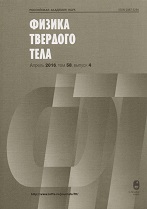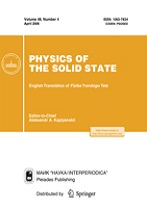|
This article is cited in 6 scientific papers (total in 6 papers)
Surface physics, thin films
Two-stage conversion of silicon to nanostructured carbon by the method of coordinated atomic substitution
S. A. Kukushkina, A. V. Osipovab, N. A. Feoktistovb
a St. Petersburg National Research University of Information Technologies, Mechanics and Optics
b Institute of Problems of Mechanical Engineering, Russian Academy of Sciences, St. Petersburg
Abstract:
A fundamentally new method of obtaining epitaxial layers of nanostructured carbon on silicon substrates has been considered. Epitaxial growth in the case of seemingly incompatible lattices has been achieved by converting the crystal by the method of coordinated substitution of atoms, in which the overall structure of the bonds between the atoms is not destroyed. In the first stage of conversion, the first half of the silicon atoms are concertedly replaced by the carbon atoms due to the reaction of silicon with CO gas, during which an epitaxial layer of SiC–3C cubic silicon carbide is obtained. In the second stage of conversion, the remaining half of silicon atoms is concertedly replaced by carbon atoms due to the reaction of SiC with CF4 gas. Carbon structures with different properties from nanodiamonds to nanotubes and carbon nanoonions have been obtained depending on the orientation of the silicon surface, pressure of the reagent gas, and temperature and growth time. A key feature of this method is that the substrate orders the resulting structures using the original chemical bonds between the atoms in silicon. The term “concertedly” means that new chemical bonds are formed simultaneously and concertedly with the destruction of old bonds. Data on electron diffraction and analysis of Raman and ellipsometric spectra of the obtained samples of nanostructured carbon on silicon substrates have been presented. Two competing growth mechanisms have been discussed.
Received: 20.09.2018
Revised: 05.10.2018
Citation:
S. A. Kukushkin, A. V. Osipov, N. A. Feoktistov, “Two-stage conversion of silicon to nanostructured carbon by the method of coordinated atomic substitution”, Fizika Tverdogo Tela, 61:3 (2019), 587–593; Phys. Solid State, 61:3 (2019), 456–463
Linking options:
https://www.mathnet.ru/eng/ftt8900 https://www.mathnet.ru/eng/ftt/v61/i3/p587
|


| Statistics & downloads: |
| Abstract page: | 92 | | Full-text PDF : | 25 |
|





 Contact us:
Contact us: Terms of Use
Terms of Use
 Registration to the website
Registration to the website Logotypes
Logotypes









 Citation in format
Citation in format 
